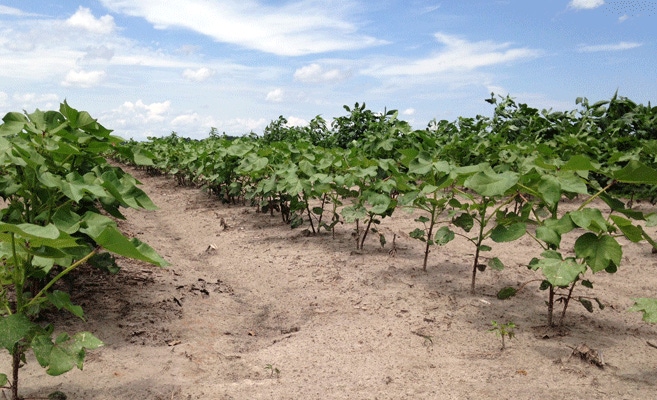
Soon farmers will face the issue of risk versus reward when it comes to the newly formulated auxin herbicides and the crops tolerant to them as the technologies get closer to being commercially available.
There is little question that growers, particularly Southeast cotton growers, need the new auxin-tolerant crops and herbicides hovering over the horizon as they continue their costly dance with herbicide-resistant weeds. Palmer amaranth pigweed has cost Georgia cotton producers alone $1 billion over the last decade, said Stanley Culpepper, a weed specialist with the University of Georgia Extension, at the Cotton Inc. 2014 Crop Management Seminar in Tifton, Ga., Nov. 12.
“The balance is the risk in managing off-target movement with the auxin herbicides (focusing on 2,4-D and dicamba) versus a potentially better, economical and more effective and sustainable weed management program,” he said.
Through the process
A seed trait with herbicide tolerance must be approved by USDA before being commercially available. Herbicides must be approved and registered by the Environmental Protection Agency before being commercially used.
Dow AgroSciences’ soybean seed trait for tolerance to Roundup, Liberty and a new formulation of 2,4-D, along with residuals already labeled, have been deregulated by the USDA. EPA also has approved the use of 2,4-D choline for these soybeans in several Midwestern states. This soybean technology will not be available for Georgia growers during 2015 but will possibly be available in 2016. It is expected that USDA will deregulate Dow’s cotton technology with tolerance to Roundup, Liberty and 2,4-D choline during 2015 with an anticipated controlled launch in Georgia during 2016, Culpepper said.

Stanley Culpepper, University of Georgia Extension weed specialist
Monsanto’s cotton seed trait will provide tolerance to Roundup, Liberty and a new formulation of dicamba, along with residuals already labeled. The Monsanto trait is currently awaiting deregulation by USDA, and, as of Dec. 15, had not received it, but it is expected for early 2015. Monsanto’s soybean trait technology will have tolerance to Roundup, dicamba, and labeled residual herbicides with an anticipated launch of 2016.
The Georgia Cotton Commission and UGA Extension, Culpepper said, are doing what they can to get the dicamba technology registered for use in 2015.
“It is critical that we get some experience (at the farmer level) on at least a small numbers of acres during 2015 with at least one of these technologies. If we don’t gain some experience in 2015, we may be in for an overwhelming experience in 2016 if soybeans and cotton with tolerance to dicamba or 2,4-D are planted for the first time in large volumes across a diverse agricultural state like Georgia," he said. "There is still a huge gap between research and farmer use, and we need to get a controlled amount of these new technologies into fields to gain experience prior to significant adoption.”
Growers will not be allowed to use older formulations of dicamba or 2,4-d with these new technologies. The newer formulations were specifically designed to limit off-target movement of the herbicides. It is important to note the Dow and Monsanto traits don’t cross over, meaning farmers cannot apply Dow’s new 2,4-D over Monsanto’s dicamba-tolerant crops or Monsanto’s dicamba over Dow’s 2,4-D tolerant crops.
Endangered Species Act complicates approval
A lawsuit put the Endangered Species Act on the EPA’s front burner, and the agency must comply attentively with it, monitoring and predicting how the new technologies might affect endangered species. That means the act now influences how fast new herbicides can be pushed to market. In other words, the more endangered species listed in a state, the longer it might take to get new herbicide technologies approved for that state.
And Georgia is blessed with 62 endangered species, with 23 of those being plants. Compare that number to some Midwest states that have only six or seven total endangered species listed, Culpepper said.
“I beat up on the EPA at times, but this is a very complex situation, and it is going to take time for them to get through it. This s is slowing us down and why we may not get it through by 2015,” said Culpepper.
There is one thing both new technologies offer which is often overlooked, Culpepper said: both cotton technologies offer essentially full tolerance to Liberty. “And Liberty is a huge benefit in the weed management programs that we’re generating for cotton growers, at least in the state of Georgia,” he said.
Off target?
Though both new auxin formulations have been designed to dramatically decrease drift and volatility, the No. 1 concern, at least in Georgia, is the off-target drift or movement of them onto sensitive crops like vegetables. There are more than 33 different vegetable crops, all high value, grown in Georgia virtually year-round. And as a weed specialist for the state’s vegetable industry, too, Culpepper said there will be some places and times where using 2,4-D or dicamba will be too risky for growers. This underlies the importance of effective education and training in the short term and long term for growers.
“In fact, UGA Cooperative Extension in conjunction with the department of agriculture are going to take an unprecedented approach in training growers on the use of 2,4-D or dicamba in these respective technologies,” said Culpepper, who added details on that training will come later in 2015.
But keep in mind, he said, that cotton growers who plant the new auxin-tolerant crops don’t have to spray 2,4-D or dicamba. They still can get excellent weed control with either technology using Liberty, Roundup and the residual herbicides offered with each new package.
Over the last decade, research and growers have caught up with resistant weeds like pigweed, and programs using Roundup or Liberty or a combination of the two with residuals plus a little hand weeding as needed now work for growers. “However, even with these new technologies,” Culpepper said, “an economically sustainable (weed) program continues to elude us.”
Using the new technologies will require operators to apply these new formulations with the best spray nozzles along with proper sprayer speed while maintaining an optimum boom height above the plant canopy and spraying during winds between 3 and 10 mph, in addition to good tank-cleaning techniques. On paper, the requirements look good and work, but in real life, these guidelines will be challenging -- doable but tough.
“Again, it’s a balancing act each grower will need to consider by weighing the risk versus reward, and what we need to do -- and must continue to do -- is to make very intelligent decisions when working to bring technologies like theses safely to market,” Culpepper said.
About the Author(s)
You May Also Like






